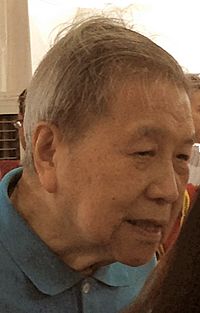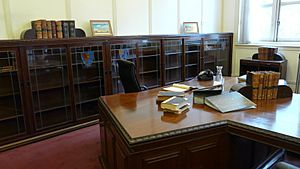Yong Pung How facts for kids
Quick facts for kids
Yong Pung How
DUBC DUT
|
|
|---|---|
| 杨邦孝 | |

Yong at the ground-breaking ceremony for the new School of Law building of Singapore Management University on 20 January 2014
|
|
| 2nd Chief Justice of Singapore | |
| In office 28 September 1990 – 10 April 2006 |
|
| Appointed by | Wee Kim Wee |
| Preceded by | Wee Chong Jin |
| Succeeded by | Chan Sek Keong |
| Judge of the Supreme Court of Singapore | |
| In office 1 July 1989 – 27 September 1990 |
|
| Appointed by | Wee Kim Wee |
| Personal details | |
| Born | 11 April 1926 Kuala Lumpur, Selangor, Federated Malay States |
| Died | 9 January 2020 (aged 93) Singapore |
| Resting place | Mandai Crematorium |
| Nationality | Singaporean |
| Spouse |
Cheang Wei-Woo
(m. 1955) |
| Alma mater | Downing College, Cambridge |
| Yong Pung How | |||||||||||||||||||
|---|---|---|---|---|---|---|---|---|---|---|---|---|---|---|---|---|---|---|---|
| Traditional Chinese | 楊邦孝 | ||||||||||||||||||
| Simplified Chinese | 杨邦孝 | ||||||||||||||||||
|
|||||||||||||||||||
Yong Pung How (11 April 1926 – 9 January 2020) was a very important judge from Singapore. He was born in Malaya. He served as the second Chief Justice of Singapore from 1990 to 2006. This means he was the highest judge in the country. President Wee Kim Wee appointed him, and he started his job on 28 September 1990.
After he finished his time as Chief Justice, Yong Pung How became the leader (chancellor) of the Singapore Management University (SMU). He held this role from 2010 to 2015. In 2021, the Yong Pung How School of Law at SMU was named after him.
Contents
Early Life and School Days
Yong Pung How was born in Kuala Lumpur, which was then part of Malaya. His family was Chinese with roots from a place called Dabu County in China. His father, Yong Shook Lin, was also a lawyer. He even started his own law firm.
Yong Pung How went to Victoria Institution for his early schooling. Later, he studied law at Downing College at Cambridge University in England. While at Cambridge, he became good friends with Lee Kuan Yew and Kwa Geok Choo. He earned his law degree in 1949. In 1952, he became a qualified lawyer.
In 1970, he also attended a special business program at Harvard Business School.
Starting His Career
After finishing his studies, Yong Pung How returned to Malaya in 1952. He became a lawyer and worked at his father's law firm.
He also helped solve problems between the government and workers. For example, in 1954, he was chosen to help settle a disagreement between the Singapore government and its workers. He also served as a chairman for courts that handled work-related disputes in Malaya and Malaysia.
Yong Pung How also held important business roles. He was the chairman of Malaysia-Singapore Airlines from 1964 to 1969. He was also the Deputy Chairman of Maybank, a big bank, from 1966 to 1972.
Working in Banking
In 1971, Yong Pung How changed his career from law to finance. He started two important banking companies: Singapore International Merchant Bankers Limited (SIMBL) and Malaysian International Merchant Bankers (MIMB). He was the chairman and managing director for both. He retired from these roles in 1976. That same year, he became the Vice-Chairman of the Oversea-Chinese Banking Corporation (OCBC), another major bank.
In 1982, the Singapore government asked him to help set up and lead two very important financial organizations. These were the Government of Singapore Investment Corporation (GIC) and the Monetary Authority of Singapore (MAS). GIC manages Singapore's money, and MAS is like Singapore's central bank. His experience in banking was very useful. He helped organize and improve how Singapore's money was managed.
In 1983, Yong Pung How returned to OCBC as its chairman and chief executive. Then, in 1989, he went back to the legal field to become a judge.
Becoming Chief Justice
On 28 September 1990, Yong Pung How became the Chief Justice. He took over from Wee Chong Jin. In his first speech, he announced some big changes. He said that judges and lawyers would no longer wear the traditional wigs in court. He also changed how people addressed judges, making it simpler.
He worked hard to make the justice system in Singapore faster and more effective. He brought in new technology to help courts process cases more quickly.
For example, in 1991, there were about 2,000 court cases waiting to be heard in the High Court. Some cases could take many years to be finished. Yong Pung How introduced new ways to solve these delays. By the time he left, a High Court case could be finished in just six months.
He also started "night courts" in lower courts. This meant people did not have to take time off work to attend court for minor issues. He also created a program to hire top law graduates to work for the courts. He also introduced the Electronic Filing System (EFS). This system used technology to make court paperwork and processes easier.
In April 2006, Yong Pung How retired as Chief Justice. Chan Sek Keong took over from him.
Awards and Special Recognitions
Yong Pung How received many important awards for his service. In 1989, he was given the Darjah Utama Bakti Cemerlang (Distinguished Service Order). On 9 August 1999, he received the Order of Temasek (First Class). This award recognized him for making the Singapore Judiciary "world class."
On 17 September 2001, the National University of Singapore Faculty of Law gave him an honorary Doctor of Laws degree. This was to honor his great work in improving Singapore's legal system. He was praised for making the courts more efficient and for clearing up many old cases.
On 14 July 2007, he received another honorary Doctor of Laws degree from the Singapore Management University (SMU). He also became the chairman of the advisory board for the SMU School of Law. In 2007, SMU also created the Yong Pung How Professorship of Law, named after him.
On 1 September 2010, Yong Pung How was appointed the Chancellor of the Singapore Management University. He held this role until 2015.
On 11 April 2021, SMU's School of Law was officially renamed the Yong Pung How School of Law in his honor.
Family Life
Yong Pung How married Cheang Wei-Woo in 1955. They met in 1950 while they were both studying. They had one daughter, Yong Ying-I. She is also a very important person in the government, working as a Permanent Secretary.
Yong Pung How passed away on 9 January 2020, at the age of 93.
He was related to other notable people. His cousin, Yong Siew Toh, has a music school named after her at the National University of Singapore. Yong Siew Toh's father, Yong Loo Lin, was a businessman and doctor. The medical school at NUS is named after him.


